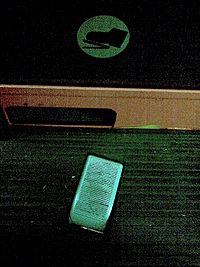
Photo from wikipedia
Rail transit systems are important parts of modern cities such as the urban subways and intercity trains. During the travelling time, many passengers access the networks via cellular communications for… Click to show full abstract
Rail transit systems are important parts of modern cities such as the urban subways and intercity trains. During the travelling time, many passengers access the networks via cellular communications for working or entertainment. However, intermittent connection of LTE signals usually decreases the user experiences, especially due to the poor LTE link quality of underground subways. On the other hand, we observe that there are usually multiple cellular operators covering a city. For example, AT&T and T-Mobile in American cities, China Mobile and China Unicom in Chinese cities. Based on the different eNodeB distributions of different operators, we propose to study a new problem cross-operator switch. Unlike the handover between eNodeBs from one operator, cross-operator switch can switch to an eNodeB belonging to other operators. Although current mobile phones support dual SIM cards and Android supports the quick swap between two cards, it is still challenging to determine which eNodeB to switch because of no information exchange between different operators. To address this challenge, we propose a robust Crowdsensing based Switch (CrowdSwitch) solution dedicated for rail transit systems. CrowdSwitch utilizes mass mobile devices of passengers to sense and collect LTE signals along subway tracks, builds the signal heat map (S-Map) in the cloud servers, and finally recommends the optimal switch taking advantages of the known tracks. We implement CrowdSwitch in off-the-shelf mobile phones and conduct extensive experiments on Shanghai Metro. The results show that CrowdSwitch can depict the accurate LTE distribution and always recommend the optimal operator for users to connect.
Journal Title: IEEE Transactions on Communications
Year Published: 2020
Link to full text (if available)
Share on Social Media: Sign Up to like & get
recommendations!